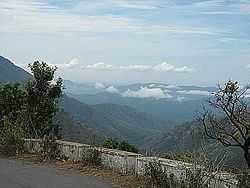Attappadi
| Attappadi | |
|---|---|
| nature reserve | |
|
Attappadi Hills of Western Ghat | |
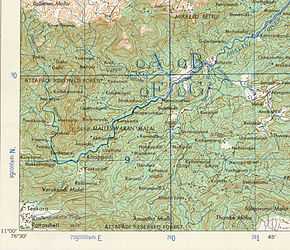 Attappati Reserve Forest | |
 Attappadi Location in Kerala, India | |
| Coordinates: 11°5′0″N 76°35′0″E / 11.08333°N 76.58333°ECoordinates: 11°5′0″N 76°35′0″E / 11.08333°N 76.58333°E | |
| Country |
|
| State | Kerala |
| District | Palakkad |
| Languages | |
| • Official | Malayalam, English |
| Time zone | IST (UTC+5:30) |
| Vehicle registration | KL- |
| Nearest city | Mannarkkad |
Attappadi Reserve Forest is a protected area comprising 249 km² of land covering the westernmost part of the 745 km² Attappadi block of Mannarghat Taluk in Palakkad district of Kerala, south India.[1]
There is a Government Goat Farm at Attapadi village which has the "Attapadi Black" breed available.[2]
Geography
Attappadi is an extensive mountain valley at the headwaters of the Bhavani River nestled below the Nilgiri Hills of the Western Ghats. It is bordered to the east by Coimbatore district in Tamil Nadu, on the north by the Nilgiris, south by the Palghat taluk and on the west by Karimba-I and II, Pottassery-I and II, and Mannarghat revenue villages of Mannarghat taluk of the Palghat District and Ernad taluk of the Malappuram district.
The 249 km² Attappadi Reserve Forest is an informal buffer zone bordering the Silent Valley National Park to the West.[3] 81 km² of this forest was separated to become most of the new 94 km² Bhavani Forest Range which is part of the 147.22 km² Silent Valley Buffer Zone formally approved by the Kerala Cabinet on 6 June 2007. The Cabinet also sanctioned 35 staff to protect the area and two new forest stations in Bhavani range at Anavai and Thudukki. The zone is aimed at checking the illicit cultivation of ganja, poaching and illicit brewing in areas adjacent to Silent Valley and help long-term sustainability of the protected area.[4]
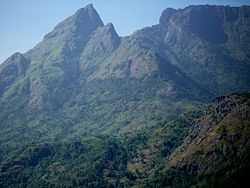
The elevation of Attappati valley ranges from 750 meters (2,460 ft) to the Malleswaram peak at 11°6′32″N 76°33′8″E / 11.10889°N 76.55222°E which rises to 1,664 meters (5,459 ft) from the center of the valley. The Bhavani River flows from the Northwest around the mountain in a tight bend past Attappadi village and continues to the Southeast.
Geology
Gneisses are the predominant rocks in Attappadi. All rock types of Attappadi other than supracrustals could be categorized into seven broad types. They are charnockite, hornblende gneiss, migmaititic amphibolite, quartz biotite gneiss, quartz-feldspathic gneiss, biotite granite gneiss, and pegmatite. Among the rock types charnockite, hornblende gneiss, migmatitic amphibolite, quartz biotite gneiss, quartz-feldspathic gneiss, and biotite granite gneiss have been identified that belong to the Peninsular Gneissic Complex. The granite and pegmatite of Attappadi represent the post-kinematic intrusives. Many dolerite dykes also have been reported from this area. The bands and layers of ultramafics and mafic rocks (Ultramafic and mafic rocks represented by metapyroxinite, talc-tremolite-actinolite schist and amphibolites) of varying dimension, BIF, sillimamite/kyanite bearing quartzite and fuchsite quartzite occurring within the Peninsular Gneissic Complex of Attappadi area designated as Attappadi Supracrustals. Remnants and enclaves of Attappadi supracrustals occur within the gneisses. BIF is another important rock type occurring in close association with the metapyroxinite and amphibolites.
Attappadi is unique in that a number of rock types varying in composition from ultramafic to metapelites occur as supracrustals. The metapelites are of granulite facies and the ultramafics are of greenschist facies and the enclosing gneisses represent amphibolites facies.
The area had undergone polyphase deformation. The planar S0, is defined by the layering within chemogenic precipitate (BIF). The earliest folds F1, apart from being tight and appressed occur in intrafolial positions and also constitute the rootless folds. This folding has given rise to an axial planar penetrative foliation and is defined mainly by hornblende and to a lesser extend by chlorite and is co-parallel to the lithoboundaries identified as S0. S1 schistosity is defined by hornblende and chlorite, and this mineralogical association suggests that the deformation occurred under upper greenschist to lower amphibolite facies conditions. The subsequent F2 resulted in refolding of S1 and transposition of S1 subparallel to the F2 axial trace. The most prominent planar structures are the discrete mylonitic foliation S2 attributed the regional NE-SW trending Bhavani shear. Mylonite development, biotitization, chloritization and microgranulation are found associated with these surfaces.[5]
Gold Mineralization
Mani 1965 reported the panning for gold by local miners in Siruvani River of Attappadi. Detailed studies to assess the economic potential of Attappadi area was carried out subsequently by Geological Survey of India. However, no primary gold prospects were identified. Nair 1993 carried out the geomorphologic mapping combined with panning of Siruvani River which led to the discovery of primary gold mineralization in epigenetic quartz vein in Puttumala. The veining, mineralization and associated lithology of this deposit appear to be typical of greenstone-hosted lode gold deposit. On the basis of mode of occurrence two types of gold mineralization are recognized in Attappadi, (1) Primary gold mineralization is associated with quartz veins intruding to AS and PGC. (2) Placer deposit along the bank of Siruvani River. The Geological Survey of India has confirmed the high gold bearing potentiality of the rocks in the 834sq km area of the Attappadi. Gold mineralization is known from Kottathara, Puttumala, Pothupadi, Mundaiyur and Kariyur-Vannathorai Prospects of Attappadi. Gold occurs in quartz veins traversing in BIF, metavolcanics, and hornblende and biotite gneiss. Deccan Gold Mines Limited later confirmed the earlier reported gold grades and have given the following values, Kottathara prospect: Three zones have been delineated and the prospect has an ore resource of 60,000 tonnes grading 13.63g/t gold according to Geological survey of India. While tracing the NE extension of Kottathara prospect, stringers of quartz analyzing 9 g/t 35 g/t and 49g/t gold have been picked up in stream beds. Puttumala prospect: A 60 cm sample of vein quartz carrying galena (lead sulfide) from old trenches showed high spot values of gold up to 21g/t. Pothupadi Prospect: A sample of vein quartz traversing amphibolite assayed 4 g/t gold. Mundaiyur Prospect: Gold occurs in quartz veins over a length of 300 m with gold-bearing sulphides enveloping the quartz veins. Kariyur-Vannathorai Prospect: Samples of vein quartz have shown gold contents ranging from 3 to 20 g/t. In Attappadi region gold grains are found only in native state and occur in different shapes and sizes. Visible specks of gold were noticed in the samples collected from veins, particularly where the associated sulphides have been subjected to weathering and leaching resulting in the formation of limonite. Gold grains with maximum dimension of 2 mm were reported. Pyrite is the dominant sulfide phase within the quartz lodes (occurring as stringers and fracture fillings). Chalcopyrite, covellite, chalcocite, and galena are commonly observed in the mineral assemblage[5]
Climate
Attapadi RF in the southwest portion of Mannarghat Forest Division receives a high rainfall of 4700 mm (185 in). Moving eastward along the Attapadi valley towards Agali,[6] the rainfall steadily decreases to a low of 900 mm.[7]
Population
There are 192 hamlets in Attapadi. The population of the valley is mostly Muduga, Irula and Kurumba tribal people with a small section of settlers from Tamil Nadu and Other Districts of Kerala.
Infrastructure
The local governments of Attappadi are the Agali, Puthur and Sholayur Grama Panchayats.
Health
There are three government primary health centres (PHC), one community health centre (CHC) and 27 subcentres in this 745-km² block. All hamlets are serviced by an effective government health extension program using trained tribal health volunteers.[8] The tribal women of 80 Attapadi hamlets are conducting a vocal campaign against liquor and ganja which has received public support from the Governor.[9] The Society of the Missionaries of St. Thomas operates the St. Thomas Ashram in Nelippathy for providing services to the tribal people of Attapadi including a 15-bed Hospital and health clinic with Lab, X-ray, Dental X-ray, ECG, Pharmacy and ambulance.there is a Tribal Super Speciality Hospital in Agali for the health care of the people with some operation theatres and facilities.
Education
St Thomas Ashram facilities include a 220 student I – VII standard English medium boarding school.[10] There are three convent schools which are the main sources of primary education located in Jellippara, kookampalayam and kottathara.these schools are running by the catholic nuns of CMC congregation. Mount Carmel High School Jellippara is the biggest one in terms of the number of students and facilities.it started English medium section and it is waiting for the secondary section. Also there is a lot of boardings and hostels for the boys and girls. For girls there are many institutions but the ordinary boys have no such a facilities other than the tribal students in Attappady. It made the CMI fathers to start a boys home in Pakkulam. Initially it was for tribal students but now it is for all. San Joss Boys home is one of the most popular institution directed by the Carmelites of Mary Immaculate Fathers CMI from the preshitha province Coimbatore. Also it is incorporated with the social service project organization the most vibrant collaboration called ASSO, the Attappady Social Service Organization. Only one government school in Agali is having the facilities of a full equipped education centre.A college of appiled sciences (IHRD College) is started in Agali, in the year 2010 for the higher education.on 2012 there is another college has started at Agali. Gov. college of Arts. Gov, IHRD college Agali has a college Union. Akhil.P.S is UUC for first time of College history. Nikhil.M.Z is College Chairman. Govt. College Attappady is the first Arts and science College in the Attappady region established under the Govt. sector in 2012.
Transportation
There are frequent local buses from Anakkatti village in Attappadi to the nearest town of Nelippathy (16 km) and Mannarghat (38 km).Sholayur
Accommodation
There are private lodges with boarding and lodging facilities in and around Agali and Goolikadavau. The PWD Guest house and the guest house at AHADS can also be utilised for accommodation.
Development projects
In 1970 the State Planning Board assessed Attappati as the most backward block in the state and the first Integrated Tribal Development Project in Kerala was initiated there. Since then, the state government has implemented several special development projects including the Attappadi Co-operative Farming Society, the Western Ghats Development Programme, the Attappadi Valley Irrigation Programme and the People's Planning Programme implemented in Attappadi in 1997–2002.
A monumental palace-like "Bharat Yatra Centre" at Agali was established in 1984 by a former Prime Minister, Chandra Shekhar, to provide employment training in weaving, pottery, embroidery and food processing to the women of this rural area. The property was occasionally occupied personally by Chandra Shekar but employment training never happened. The leaders of Girijan Sevak Samaj (GSS), the major tribal body in Attappadi, stated that the center was built on original tribal lands possessed illegally.
In 2000 The Centre at Attappadi and its huge building were deserted and unoccupied.[11]
Many of these projects were not well adapted to traditional adivasi culture and beliefs so about 80 per cent of the tribal population is still living in abject poverty. Attappadi demonstrates how difficult it is for a modern government development process to succeed in a traditional self-sustaining indigenous peoples (adivasi) community. Tribal people are a majority of the Attappadi population but have a high illiteracy rate of 49.5 per cent and a lack of political and administrative awareness. The majority of project managers and new land owners are from other parts of Kerala, Tamil Nadu and other states.
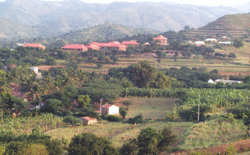
The Attappadi Comprehensive Environmental Conservation and Wasteland Development Project was established in 1995, with local operations managed from their Agali Headquarters. This project has Rs. 2.19 billion ($5,000,000) development assistance loan from the Japan Bank for International Cooperation (JBIC) and is implemented by the Attappadi Hills Area Development Society (AHADS),[12] a state government agency. AHADS has made good quantified achievements[13] that will bring long term benefit to the valley.
Attappady Social Service Organisation (ASSO) is one of the major Social Service Organization functioning in Attappady. It successfully implemented World Bank aided 'Jalanidhi' project to provide drinking water facility for the tribal community.
Festival
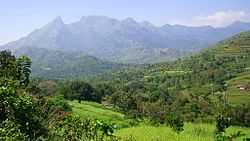
The Sivarathri festival is celebrated at the chemmannur Malleswaran temple by the tribals during the month of February/March. The Malleswaran peak is worshipped as a gigantic Shivalinga by the adivasis who celebrate the Sivarathri festival there with great fervour.
At the Ayyappan temple in Agali, Ayyappan Vilakku is celebrated in January. The feast of Sehion Pentecost is celebrated in Sehion Retreat Centre Thavalam in June. The retreat sermons in the Calvary Mount Shrine in Jellippara St. Peter's Catholic Church in the 40th Friday of the lenten season is very attractive to all people. The way of the cross to the Calvary Mount Shrine from Jellippara Parish church in the Good Friday is also a celebrative mood for Christians.
References
- ↑ Suchitra M.(8/8/2005) "Remote adivasis face health care chasm" Free India Media, retrieved 4/3/2007 "Remote adivasis..."
- ↑ Public Relations Department, Govt. of Kerala, "Where to get" Department of Amimal Husbandry, retrieved 4/1/2007 "Where to get"
- ↑ keralaatbest.com (2002) "Palgat", retrieved 4/1/2007 Palgat
- ↑ J The Hindu, Front page, retrieved 8 June 2007 Cabinet approves buffer zone for Silent Valley 6 June 2007
- ↑ 5.0 5.1 pradeepsz PhD thesis Genesis of gold mineralization in Attappadi
- ↑ Agali, attappadi
- ↑ Asian Nature Conservation Foundation (2006) "NILAMBUR-SILENT VALLEY-COIMBATORE – PERSPECTIVE FOR THE RESERVE" retrieved 29 March 2007 PERSPECTIVE FOR THE RESERVE
- ↑ COMMUNITY MENTAL HEALTH PROJECT PDF file
- ↑ Hindustan times, Kerala, ( 21 March 2007) "Kalam starts Attapadi anti-liquor campaign", retrieved 21 April 2007 Attapadi anti-liquor campaign
- ↑ Society of the Missionaries of St. Thomas, "St.Thomas Ashram"St. Thomas Ashram
- ↑ Interdisciplinary Biannual Journal PDF file
- ↑ AHADS, index AHADS
- ↑ Attappadi Hills Area Development Society, (2005) "Achievements" Retrieved 4/4/2007
| Wikimedia Commons has media related to Attappadi. |
